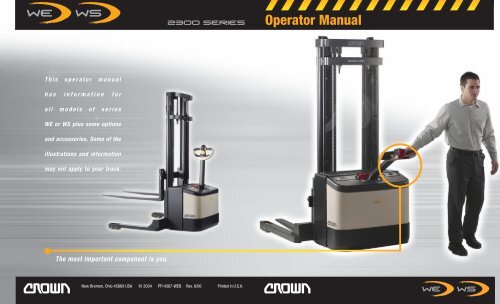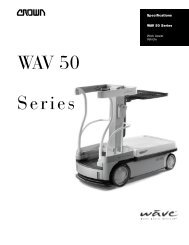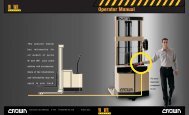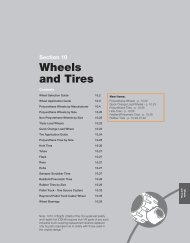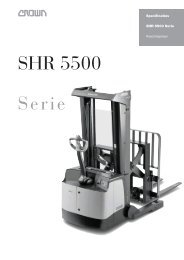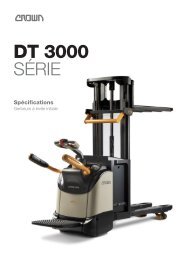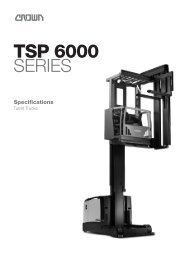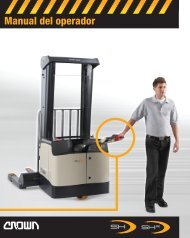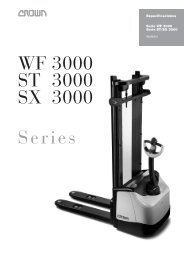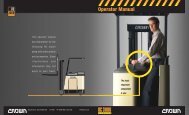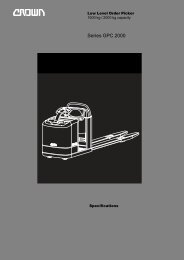WE / WS 2300 - Crown Equipment Corporation
WE / WS 2300 - Crown Equipment Corporation
WE / WS 2300 - Crown Equipment Corporation
Create successful ePaper yourself
Turn your PDF publications into a flip-book with our unique Google optimized e-Paper software.
New Bremen, Ohio 45869 USA © 2004 PF14387-<strong>WE</strong>B Rev. 6/06 Printed in U.S.A.
1 Warning<br />
It’s the law, you must be trained and certified to operate this<br />
truck. (OSHA § 1910.178, Rev. 1999)<br />
You or others around you can be seriously injured or even<br />
killed if you don't use this truck correctly.<br />
Read and obey all warnings and instructions in this Manual*<br />
and on the truck.<br />
Head, arms, hands or legs outside the operator area can<br />
be pinned or crushed whenever the truck is moving. Stay<br />
within the operator area and stop your truck completely before<br />
getting off.<br />
A dockboard can move or drop while you are on it. Or<br />
you could drive off a dock. Falls from docks or dockboards<br />
can cause serious injury or even death. Make sure you are<br />
safe.<br />
Inspect your truck before starting work, make sure it is in<br />
good working order.<br />
* Additional copies of this Operator Manual and all Truck Labels can be<br />
obtained from <strong>Crown</strong> <strong>Equipment</strong> <strong>Corporation</strong>, New Bremen, Ohio 45869<br />
U.S.A.<br />
All rights reserved under International<br />
and Pan American copyright conventions<br />
Copyright 2005 <strong>Crown</strong> <strong>Equipment</strong> Corp.<br />
You Must be Trained<br />
STOP<br />
IT'S THE LAW, YOU MUST BE TRAINED<br />
Federal law states that only trained and authorized<br />
operators are permitted to operate a powered industrial<br />
truck. Your employer is required to train operators in<br />
the safe operation of powered industrial trucks. (OSHA<br />
§1910.178)<br />
Do not operate this truck in your work place until you have<br />
been trained and certified by your employer.<br />
You could be killed or seriously injured if you are not<br />
adequately trained for lift truck operation!<br />
You Must be Trained 2
Protect Yourself<br />
Know the Hazards<br />
Recommended<br />
Walking Path<br />
3 Protect Yourself<br />
LOOK WHERE YOU'RE GOING<br />
Always be alert to the area around you and watch where<br />
you are driving. Be careful that you don't get pinned or<br />
crushed between the truck and a fixed object such as a<br />
wall or post.<br />
USE YOUR TRUCK CAREFULLY<br />
• Watch your hands and your feet. A foot or hand caught<br />
between the truck and a fixed object will be crushed<br />
or even cut off.<br />
• Keep to the side of the truck while traveling power unit<br />
first. Make certain the truck won't hit the back of your<br />
leg or foot. Don't let the truck run over your foot.<br />
• If traveling forks first, keep both hands on the control<br />
handle and be careful when changing direction of<br />
travel. Keep your feet clear of the truck.<br />
• Keep your truck under control at all times. Operate at<br />
a speed that allows you to stop safely. Be even more<br />
careful on slippery or uneven surfaces. Do not run<br />
over objects on the floor.<br />
• Perform all truck movements smoothly and at a speed<br />
that will give you time to react in an emergency.<br />
07<br />
Know the Hazards<br />
WARNI NG<br />
Stay clear of all<br />
moving parts.<br />
Moving parts can<br />
cut or crush hands,<br />
feet, arms or legs.<br />
AVOID FALLS AND TIPOVERS<br />
Tipovers and falls are very serious accidents, you can be<br />
crushed or even killed. The best way to prevent injury<br />
is to know where you are at all times and follow the rules<br />
of safe truck operation.<br />
• Be extremely careful when working around docks,<br />
dockboards and trailers.<br />
• Stay away from the edge of docks and ramps.<br />
• Make sure dockboards are secure.<br />
• Check that trailer wheels are chocked.<br />
• Travel with the load or forks close to the ground.<br />
Watch for overhead obstructions. Perform all truck<br />
movements smoothly and at a speed that will give<br />
you time to react in an emergency.<br />
• An unloaded truck can tip over also. You must be just<br />
as careful using an unloaded truck as you are using a<br />
loaded one.<br />
USE YOUR TRUCK SAFELY<br />
• Keep your hands and feet away from all moving parts<br />
such as masts, chains, forks or wheels. Make sure the<br />
load backrest (standard on the <strong>WE</strong>) is in place and<br />
secure.<br />
• Never stand on or under the forks, or allow anyone<br />
else to stand on or under them. The only way to lift<br />
people is with an approved platform. Never ride on<br />
the truck or let anyone else ride. There is no safe place<br />
to sit or stand.<br />
• Before you leave your truck:<br />
• Lower the forks to the floor.<br />
• Shut the truck off with the key or disconnect the battery.<br />
Protect Yourself 4
Contents<br />
Warning<br />
You Must be Trained<br />
Protect Yourself<br />
Contents<br />
What's in it for You?<br />
Your Walkie Lift Truck<br />
Lift Truck Parts<br />
Capacity & Load Center<br />
Capacity Plate<br />
Power On & Off<br />
Braking & Brake Override<br />
Raising & Lowering<br />
Steering & Travel<br />
Traveling & Plugging<br />
Daily Safety Check<br />
Be a Safe Operator<br />
Battery Maintenance<br />
Warning Labels<br />
5 Contents<br />
1<br />
2<br />
3<br />
5<br />
6<br />
7<br />
9<br />
11<br />
13<br />
15<br />
16<br />
17<br />
18<br />
19<br />
21<br />
23<br />
27<br />
30<br />
Load<br />
Center<br />
Center of evenly<br />
distributed load<br />
24" Max<br />
(600mm)<br />
What's in it for You?<br />
Know the Hazards<br />
436-B<br />
Truck Weight with Max. Battery<br />
1300(2869)<br />
E<br />
---------------<br />
A987654<br />
SAMPLE<br />
1360(3000) 4420(174) 600(24)<br />
1815(4000) 3657(144) 600(24)<br />
1050(2310) 4420(174) 800(32)<br />
1345(2970) 3657(144) 800(32)<br />
Capacity & Load Center 12<br />
WHAT'S IN IT FOR YOU?<br />
The better you understand your truck and how to use it,<br />
the better and safer operator you can be. Here are some<br />
guides to using this manual.<br />
QUICK LOCATORS<br />
In addition to the "Contents" page you<br />
can use page headings to find topics.<br />
Some pages also have a picture of the<br />
truck in the corner showing features<br />
or functions covered on that page.<br />
"KNOW THE HAZARDS"<br />
Watch for and read these special<br />
blocks. You will find information about<br />
possible safety hazards and how to<br />
avoid them.<br />
HOW-TO-DRAWINGS<br />
On many pages you will find pictures<br />
as well as text to help you understand<br />
how to use your truck safely and<br />
productively.<br />
What's in it for You? 6
Your Walkie Lift Truck<br />
Path of<br />
Truck<br />
Recommended<br />
Walking Area<br />
7 Your Walkie Lift Truck<br />
WALKIE LIFT TRUCKS<br />
Your walkie lift truck can be used to lift, move<br />
and stack loads. It is designed to travel short<br />
distances and operate in areas with limited<br />
space.<br />
YOUR LIFT TRUCK IS NOT AN AUTOMOBILE<br />
With a load it may weigh more than<br />
2 automobiles.<br />
• You don't steer the same.<br />
• You don't brake the same.<br />
• You don't accelerate the same.<br />
HOW TO OPERATE YOUR TRUCK<br />
Forks First<br />
When traveling forks first use both hands to<br />
operate the control handle.<br />
Watch your feet if you change direction of<br />
travel.<br />
Power Unit First<br />
When traveling power unit first stay to one side<br />
of the truck and slightly ahead of the power<br />
unit. Use the hand closest to the truck to<br />
operate the control handle.<br />
Watch your feet.<br />
Stay out of the path of the truck.<br />
BUILT TO STANDARDS<br />
This truck was designed and built<br />
to current industry and government<br />
standards and guidelines. For more<br />
information see the following:<br />
• American National Standards<br />
Institute (ANSI/ITSDF) B56.1<br />
• Occupational Safety & Health<br />
Act (OSHA) §1910.178<br />
• Underwriters Laboratory<br />
(UL) 583<br />
• National Fire Prevention<br />
Association (NFPA) 505<br />
Hand on<br />
the control<br />
Walk to the side<br />
Feet clear of the truck<br />
Your Walkie Lift Truck 8
Lift Truck Parts<br />
Mast<br />
Key Switch<br />
Control Handle<br />
Power<br />
Disconnect<br />
Power Unit<br />
Battery<br />
Forks<br />
Load Wheels<br />
9 Lift Truck Parts<br />
High Travel Speed Switch<br />
Reversing Button<br />
Raise Button<br />
Lower Button<br />
Forward/Reverse Rockers<br />
Horn Buttons ( under side of grips )<br />
Lift Truck Parts 10
Capacity & Load Center<br />
Load<br />
Center<br />
Center of evenly<br />
distributed load<br />
24" Max<br />
(600mm)<br />
11 Capacity & Load Center<br />
WHAT IS YOUR TRUCK CAPACITY?<br />
Capacity is the load (including pallet or<br />
container) that can be lifted to a given height<br />
at a given load center. See the capacity plate on<br />
your truck.<br />
WHAT IS LOAD CENTER?<br />
Load center is the distance from the load backrest<br />
or vertical face of the fork to the center of an evenly<br />
distributed load.<br />
LOADS MUST BE EVENLY DISTRIBUTED<br />
Your truck could tip over if a load is shifted to the<br />
front or side of a pallet or container. Make sure<br />
your load is evenly distributed and centered over<br />
the forks.<br />
Know the Hazards<br />
Truck Weight with Max. Battery<br />
1300(2869)<br />
E<br />
---------------<br />
A987654<br />
SAMPLE<br />
1360(3000) 4420(174) 600(24)<br />
1815(4000) 3657(144) 600(24)<br />
1050(2310) 4420(174) 800(32)<br />
1345(2970) 3657(144) 800(32)<br />
KNOW YOUR LOAD<br />
Do not exceed the capacity shown on your truck's<br />
capacity plate. Be careful when handling long, high or<br />
wide loads. Do not handle unstable loads.<br />
EXCEEDING TRUCK CAPACITY CAN CAUSE AN ACCIDENT<br />
Know the capacity of your truck as shown on your<br />
capacity plate. Pay attention to:<br />
• Weight of load<br />
• Load center<br />
• Lift height<br />
HYDRAULIC OPERATIONS CAN AFFECT STABILITY<br />
Be careful when using attachments such as sideshift,<br />
pivot or rotate. Remember that anytime the forks move,<br />
the load moves also. This can affect stability. Perform<br />
all hydraulic operations smoothly.<br />
CENTER THE LOAD<br />
Your truck could tip over, in any direction, if a load is<br />
shifted to the front or side of a pallet or container. Make<br />
certain your load is centered and evenly distributed.<br />
Capacity & Load Center 12
Capacity Plate<br />
SAMPLE<br />
CAPACITY PLATE<br />
The information<br />
shown on this<br />
sample plate<br />
does not apply<br />
to your truck.<br />
13 Capacity Plate<br />
Truck Weight with Max. Battery<br />
1300(2869)<br />
E<br />
---------------<br />
A987654<br />
CAPACITY PLATE INFORMATION<br />
The capacity plate is on the<br />
top of the power unit. It contains:<br />
• Truck serial number<br />
• Capacity information (load, load center and lift height)<br />
• Truck type (a fire safety rating)<br />
• Truck weight with battery (does not include load)<br />
• Attachment information (if any)<br />
READING YOUR CAPACITY PLATE<br />
Capacity may be reduced as lift height A increases.<br />
For example: On the sample plate, 1815kg (4000 lb) can<br />
be lifted to 3657mm (144 in.). But above 3657 (144),<br />
to 4420 (174), capacity is reduced from 1815 (4000) to<br />
1360 (3000).<br />
Capacity is reduced as load center B increases.<br />
For example: On the sample plate, 1815kg (4000 lb) can<br />
be lifted if the load center is 600mm (24 in.) But if the<br />
load center is increased to 800mm (32 in.), capacity is<br />
reduced from 1815 (4000) to 1345 (2970).<br />
SAMPLE<br />
1360(3000) 4420(174) 600(24)<br />
1815(4000) 3657(144) 600(24)<br />
1050(2310) 4420(174) 800(32)<br />
1345(2970) 3657(144) 800(32)<br />
CAUTION<br />
You may not increase capacity if load<br />
center is less than shown on your<br />
capacity plate.<br />
Note: ANSI/ITSDF B56.1 requires that<br />
all data be shown first in Metric units<br />
and then USA units.<br />
Know the Hazards<br />
OTHER LIFT HEIGHTS & LOAD CENTERS<br />
Contact <strong>Crown</strong> for capacities at lift heights or load centers<br />
not given on your capacity plate.<br />
TRUCK <strong>WE</strong>IGHT<br />
Dockboards, elevators and some floors have limited<br />
capacity. Check your capacity plate for the weight of<br />
your truck. Remember to add the weight of the load you<br />
have on the forks.<br />
TRUCK TYPE<br />
Some truck types are not permitted in areas where there<br />
are fire hazards. Watch for marked areas. For example:<br />
You must not drive a type E or ES truck in an area<br />
restricted to EE or EX trucks.<br />
ATTACHMENT DATA<br />
If an attachment on your truck does not match the<br />
information given here on your capacity plate, don't<br />
operate your truck. Your capacity plate may be wrong.<br />
Report the problem to your supervisor.<br />
Capacity Plate 14
0<br />
Power On & Off<br />
+ -<br />
1 2 3 4 5 . 6<br />
1/2<br />
1__<br />
10<br />
1<br />
0<br />
1/2<br />
+ -<br />
1 2 3 4 5 . 6<br />
15 Power On & Off<br />
1<br />
1__<br />
10<br />
KEY SWITCH<br />
Turn the key clockwise. Power is ON.<br />
Turn the key counterclockwise. Power is OFF.<br />
Always turn the key off when leaving the truck.<br />
PO<strong>WE</strong>R DISCONNECT<br />
Push the battery connector handle down to disconnect<br />
the battery and cut all power.<br />
Always disconnect the battery any time the truck isn't<br />
working right. The key switch does not cut all power to<br />
the truck.<br />
Don't use the truck if it's not working right. Report the<br />
problem to your supervisor.<br />
BATTERY CHARGE METER OPTION<br />
The green and yellow lights show how much charge is<br />
left in your battery. A flashing red light will warn you<br />
that the battery is getting low. Two flashing red lights<br />
mean you must have the battery changed or recharged.<br />
Braking & Brake Override<br />
Brake On<br />
Brake On<br />
Brake<br />
Override<br />
Brake Off<br />
Brake On<br />
Know the Hazards<br />
?<br />
BRAKING<br />
Move the control handle all the way down or all the way<br />
up to apply the brake.<br />
When you let go of the control handle it will automatically<br />
go to the upper braking position. Check braking before<br />
you start working.<br />
BRAKE OVERRIDE<br />
If you must move your truck while in a confined area,<br />
this feature allows you to override the brake and drive<br />
slowly while the handle is in the upper "Brake On" area.<br />
With the handle in the "Brake Override" part of the braking<br />
area, first put the forward/reverse rocker in neutral, and<br />
then move it to the direction you want to travel.<br />
Watch your feet. Make sure you don't get pinned between<br />
the truck and a fixed object. Stay to the side of the truck.<br />
MAKE SURE YOUR BRAKE WORKS<br />
Test the brake on your truck at the start of each shift.<br />
Know the distance it takes to stop before starting to<br />
work.<br />
If at any time the stopping distance is too long for you<br />
to stop safely, don't use the truck. Report any problem<br />
to your supervisor.<br />
BE CAREFUL WHILE USING BRAKE OVERRIDE<br />
Hands or feet caught between the truck and a fixed object<br />
will be crushed or even cut off. Stay to the side of the<br />
truck.<br />
Braking & Brake Override 16
Raising & Lowering<br />
17 Raising & Lowering<br />
TO RAISE<br />
Push the Raise Button and release when the forks are<br />
at the desired height.<br />
TO LO<strong>WE</strong>R<br />
Push the lower button all the way for fast lowering.<br />
Push the button part way for a slower lowering speed.<br />
Release the button when the forks are at the desired<br />
height.<br />
Steering & Travel<br />
STEERING<br />
You control steering by moving the control handle from side to side.<br />
For example: This picture shows the directions the truck can turn when<br />
the control handle is moved to the approximate position shown.<br />
Travel, power<br />
unit first<br />
Direction<br />
of Turn<br />
Know the Hazards<br />
Direction<br />
of Turn<br />
Travel,<br />
forks first<br />
PO<strong>WE</strong>R UNIT SWING<br />
Be careful turning while traveling forks first. The power<br />
unit will swing wide in the opposite direction. Make sure<br />
you have clearance, and watch out for people in the area.<br />
SLOW DOWN FOR SPILLS OR <strong>WE</strong>T FLOORS<br />
Powder or liquid spills can cause slippery floors. Slow<br />
down or you could lose control of steering and braking.<br />
Be careful and allow for a longer stopping distance.<br />
Don't run over objects on the floor.<br />
Steering & Travel 18
Traveling & Plugging<br />
19 Traveling & Plugging<br />
TRAVEL<br />
Move either Forward/Reverse Rocker<br />
in the direction you want to travel.<br />
The farther you move the rocker from the neutral<br />
position, the faster the truck will move.<br />
HIGH TRAVEL SPEED<br />
For high travel speed, turn the travel speed switch<br />
to the high speed position ( ), and move either<br />
Forward/Reverse Rocker to the max. travel speed position.<br />
For a slower max. travel speed, turn the travel speed<br />
switch to the low speed position ( ).<br />
PLUGGING<br />
Plugging is another way to slow down your truck.<br />
While the truck is moving, in either direction, move either<br />
Forward/Reverse rocker through neutral to the opposite<br />
direction of travel.<br />
Plugging will not hurt your truck.<br />
REVERSING BUTTON<br />
If you accidentally hit the reversing button while working<br />
in close quarters, the truck will move in the direction of<br />
the forks until the button is released.<br />
Be careful. The reversing button cannot prevent all<br />
injuries.<br />
Know the Hazards<br />
HORN<br />
Push the switch on the underside of the grips to sound<br />
the horn. Use it to warn pedestrians and other drivers.<br />
Use your horn when you come to an intersection or a<br />
crosswalk.<br />
LOOK WHERE YOU'RE GOING<br />
Always be alert to the area around you and watch where<br />
you are walking. You could be pinned or crushed if you<br />
are caught between the truck and walls, racks or other<br />
fixed objects.<br />
WATCH YOUR FEET AND HANDS<br />
A foot or hand caught between the truck and a wall,<br />
post or any fixed object will be crushed or even cut off.<br />
Keep your feet clear of the wheels.<br />
Traveling & Plugging 20
Daily Safety Check<br />
CHECK YOUR TRUCK BEFORE STARTING WORK<br />
You must make sure your truck is safe to use.<br />
1. Walk around your truck and check it over.<br />
• Check to make sure the battery is charged, water level<br />
is OK and vent caps are in place. Don't use an open<br />
flame to check the battery.<br />
21 Daily Safety Check<br />
• See that all wheels are in good condition.<br />
• Check that both forks are secure and not bent, cracked<br />
or badly worn.<br />
• Inspect lift chains for damage.<br />
• See that the load backrest is in place and secure, if<br />
your truck has that option.<br />
• Look under the truck for signs of hydraulic leaks.<br />
• Try the horn.<br />
• Make sure the power disconnect works.<br />
• Check that all controls work smoothly.<br />
2. Test drive your truck in an uncongested area.<br />
• Try all the hydraulic functions.<br />
• Check the steering.<br />
• Operate the truck slowly in both directions.<br />
• Operate through the full speed range in both forward<br />
and reverse.<br />
• Check braking distance in forward and reverse. Load<br />
size and floor conditions can affect these distances.<br />
• Know the distance it takes to stop before you start<br />
working. If the braking distance is too long to stop<br />
safely, don't use the truck.<br />
If anything doesn't look, work or feel right, don't use the truck. Report<br />
the problem to your supervisor.<br />
You can get checklist forms from your <strong>Crown</strong> dealer<br />
(part no. OF-3772). Used properly, this checklist can alert<br />
service people to needed repairs.<br />
Daily Safety Check 22
Be a Safe Operator<br />
The most<br />
important<br />
component<br />
is you.<br />
?<br />
23 Be a Safe Operator<br />
MAKE SURE YOU ARE READY<br />
• Do not use this truck unless you are trained<br />
and authorized.<br />
• Be certain you understand how your truck works and<br />
the hazards that go with it. Don't use the truck if you<br />
have any doubts.<br />
• Know the capacity of your truck.<br />
• Some trucks are not allowed in areas where thereare<br />
fire hazards. Be certain your truck is the correct fire<br />
safety type for the area.<br />
• Make sure your hands and shoes are clean and dry,and<br />
your clothing is proper for the job.<br />
MAKE SURE YOUR TRUCK IS READY<br />
• Inspect your truck before using it (see pages 21 and<br />
22). If it's not working right, or something is broken,<br />
report the problem to your supervisor. Don't use the<br />
truck.<br />
• In an open area, test the braking. Check at a slow<br />
travel speed first, then a faster one. Know the distance<br />
it takes to stop before you start work.<br />
Recommended<br />
Walking Path<br />
USE CAUTION, BE ALERT<br />
• Watch where you're walking. Don't let any part of your<br />
body get pinned or crushed between the truck and a<br />
fixed object.<br />
• Stay to the side of the truck when traveling power unit<br />
first. Make sure the truck won't hit your leg or run over<br />
your foot.<br />
• When traveling forks first keep both hands on the<br />
control. Be careful when changing direction. Keep<br />
your feet clear of the truck.<br />
• Travel in the direction that gives you the best view.<br />
Look where you are going and slow down in congested<br />
areas.<br />
• Slow down for wet or slippery floors. Don't run over<br />
things. Watch out for rough floors.<br />
• Travel with the forks close to the ground. Place the<br />
load against the load backrest or vertical face of the<br />
forks.<br />
• Look where you are going before you change direction<br />
of travel.<br />
• See that you have room to drive and turn. Watch out<br />
for power unit swing.<br />
• Slow down when making turns.<br />
• Avoid sudden movement of controls. Learn to use<br />
them smoothly at a moderate, even rate.<br />
• Check clearances before raising or lowering the forks.<br />
• Be extra careful if you must use your truck in an area<br />
where there is a risk of falling objects.<br />
• Never ride on your truck.<br />
Continued next page...<br />
Be a Safe Operator 24
Be a Safe Operator continued<br />
25 Be a Safe Operator continued<br />
WATCH OUT FOR OTHER PEOPLE<br />
• Slow down. Yield or stop for pedestrians.<br />
Use your horn when you come to a crosswalk or<br />
intersection.<br />
• Be careful that you don't pin or crush someone.<br />
For example: Never drive your truck toward anyone<br />
standing in front of a fixed object.<br />
• Never allow anyone to ride on your truck.<br />
• Keep others away from your truck while you're working.<br />
Don't ever allow anyone on or under the load or forks.<br />
• Don't let anyone use your truck unless they are trained<br />
and authorized.<br />
• Watch out for power unit swing.<br />
• Never lift anyone with the forks unless they are using<br />
an approved platform. Even then use extreme caution:<br />
• Use a securely attached and approved safety platform.<br />
• Make certain lifting mechanism is operating properly.<br />
• Make certain truck is in neutral and brake is applied.<br />
• Lift and lower slowly.<br />
• Watch for overhead obstructions.<br />
• Be sure you can see and hear the person being lifted.<br />
• Never transport anyone on the platform from one<br />
location to another.<br />
WHEN LEAVING YOUR TRUCK<br />
• Lower the forks to the floor. Turn the truck off or<br />
disconnect the battery.<br />
• Avoid parking on inclines. But if you must, block the<br />
wheels of your truck.<br />
AVOID FALLS<br />
• Stay away from the edge of docks and ramps.<br />
• Check that bridgeplates and dockboards are secure.<br />
Be certain that either the trailer wheels are chocked or<br />
the trailer is locked to the dock. Check capacities. Be<br />
sure your truck, with load, isn't too heavy for where<br />
you are driving.<br />
• Make sure the load you are moving is stable. Spread<br />
the forks as far as you can and center the load. Insert<br />
the forks as far under the load as you can. Be even<br />
more careful with long, high or wide loads. They can<br />
be less stable.<br />
• Don't take your truck onto an elevator unless you are<br />
authorized. Check the capacity or load limit and make<br />
sure there are no people present. Enter forks first and<br />
set the brake.<br />
BE CAREFUL TRAVELING ON RAMPS AND GRADES<br />
• Stay out of the path of the truck.<br />
• With or without a load, drive with the forks pointed<br />
downgrade.<br />
• If a load requires that you travel with the forks upgrade,<br />
be even more careful. Operate the controls from the<br />
side of the truck.<br />
• Slow down and don't turn on ramps or grades.<br />
Be a Safe Operator continued 26
Battery Maintenance<br />
27 Battery Maintenance<br />
WHEN YOU INSTALL OR CHANGE A BATTERY<br />
• Turn the truck OFF. Check that all controls<br />
are in neutral.<br />
• Make certain you use the correct size and weight<br />
battery. Never operate a truck that has an underweight<br />
or undersized battery installed.<br />
• Never let anything metal touch the top of the cells.<br />
You could cause sparks or do damage to the battery.<br />
Use an insulator (such as plywood) when necessary.<br />
• Use an approved spreader bar to place a battery in, or<br />
remove it from, the battery compartment or roller stand.<br />
Make sure you adjust the spreader bar hooks to fit the<br />
battery.<br />
USING A ROLLER STAND<br />
• If you use a roller stand to install or remove a battery,<br />
make sure the roller stand is the same height as the<br />
rollers in the truck's battery compartment. Also make<br />
sure the roller stand is at least as long as your battery.<br />
AFTER INSTALLING YOUR BATTERY<br />
• Replace the battery retainer. Make certain the retainers<br />
on both sides of the truck are in place.<br />
• Connect the battery. Turn the truck ON and check<br />
truck operation.<br />
Know the Hazards<br />
Batteries produce explosive gas.<br />
Do not smoke, use open flame, or<br />
create an arc or sparks near this<br />
battery. Ventilate well in enclosed<br />
areas and when charging.<br />
Batteries contain Sulfuric Acid which<br />
causes severe burns. Do not get in<br />
eyes, on skin, or clothing. In case of<br />
contact, flush immediately. Get medical<br />
attention if your eyes are affected.<br />
000<br />
000<br />
WARNI NG<br />
00.00<br />
00.00<br />
107<br />
TRUCK BATTERIES CAN BE DANGEROUS<br />
Your truck battery produces fumes that can explode.<br />
It also contains acid that could burn or disfigure you.<br />
• Do not try to install, remove, charge or service your<br />
truck battery unless you are trained and authorized.<br />
• Never smoke or use an open flame around batteries.<br />
• Your company should provide an area where it is safe<br />
to work on batteries. Use that area for all battery work.<br />
• Use protective equipment such as gloves, eye shields,<br />
apron, etc.<br />
BATTERY RETAINERS<br />
The battery could slide out if battery retainers are not in<br />
place. Check both sides of the truck.<br />
BATTERY SIZE<br />
Make certain you use the correct size and weight battery.<br />
Never operate a truck that has an underweight or<br />
undersized battery installed.<br />
Battery Maintenance 28
Battery Maintenance continued<br />
Know the Hazards<br />
29 Battery Maintenance continued<br />
BEFORE CHARGING YOUR TRUCK BATTERY<br />
• Charge the battery only in areas designated for that<br />
use.<br />
• See that the battery cells are filled to the proper level.<br />
Never use an open flame to check the battery.<br />
• Make certain the charger is the same voltage and<br />
amperage as your battery.<br />
• Read the battery charger instructions.<br />
• Be sure the charger is turned OFF before connecting<br />
the battery to the charger. Otherwise you might create<br />
a spark which could cause the battery to explode.<br />
Also, make sure the truck key switch is turned off and all<br />
controls are in the off position.<br />
Warning Labels<br />
WARNI NG<br />
All rights reserved under International<br />
and Pan American copyright conventions<br />
Copyright 2005 <strong>Crown</strong> <strong>Equipment</strong> Corp.<br />
10<br />
54<br />
54<br />
000<br />
000<br />
09<br />
WARNI NG<br />
47<br />
00.00<br />
00.00<br />
20<br />
07<br />
Stay clear of all<br />
moving parts.<br />
36<br />
DANGER<br />
Warning Labels 30


